Effects of systemic or nucleus accumbens-directed dopamine D1 receptor antagonism on sucrose seeking in rats
- PMID: 21318562
- PMCID: PMC3120924
- DOI: 10.1007/s00213-011-2210-y
Effects of systemic or nucleus accumbens-directed dopamine D1 receptor antagonism on sucrose seeking in rats
Abstract
Rationale: Conditioned cues can elicit relapse to drug- and food-seeking behavior over prolonged periods of abstinence. If seeking behavior depends on mesolimbic dopamine D1 receptors, blocking these receptors should reduce seeking behavior.
Objectives: We examined the effects of either systemic or intra-nucleus accumbens administration of the D1 antagonist SCH 23390 on extinction responding (sucrose seeking) by rats either 1 or 30 days into forced abstinence.
Materials and methods: Rats self-administered 10% sucrose paired with a tone + light cue for 10 days. After either 1 or 30 days of forced abstinence, rats received systemic (0, 1, 5, or 25 μg/kg IP) or bilateral nucleus accumbens core or shell (0.3 or 0.6 μg/site) injections of SCH 23390 prior to extinction testing.
Results: Saline-treated rats responded more during extinction following 30 vs. 1 day of forced abstinence ("incubation of craving"). Systemic SCH 23390 reduced sucrose seeking after 1 day of forced abstinence, significantly reducing responding following pretreatment with 1, 5, and 25 μg/kg SCH 23390, but only 25 μg/kg significantly reduced sucrose seeking after 30 days of forced abstinence. SCH 23390 (0.3 or 0.6 μg/site) in the core or shell of the nucleus accumbens reduced sucrose seeking in all groups.
Conclusion: Nucleus accumbens D1 receptors are involved in sucrose seeking, but it is not clear if they are involved in the incubation of craving. The fact that D1 antagonism reduced sucrose seeking across an extended period of abstinence may be of use for development of treatment strategies for relapse.
Conflict of interest statement
Figures
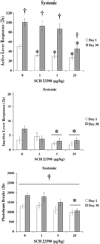
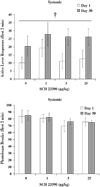


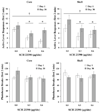
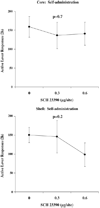
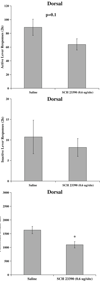
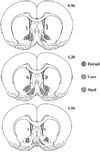

References
-
- Alleweireldt AT, Hobbs RJ, Taylor AR, Neisewander JL. Effects of SCH-23390 infused into the amygdala or adjacent cortex and basal ganglia on cocaine seeking and self-administration in rats. Neuropsychopharmacology. 2006;31:363–374. - PubMed
-
- Alleweireldt AT, Weber SM, Kirschner KF, Bullock BL, Neisewander JL. Blockade or stimulation of D1 dopamine receptors attenuates cue reinstatement of extinguished cocaine-seeking behavior in rats. Psychopharmacology (Berl) 2002;159:284–293. - PubMed
-
- Bachtell RK, Whisler K, Karanian D, Self DW. Effects of intra-nucleus accumbens shell administration of dopamine agonists and antagonists on cocaine-taking and cocaine-seeking behaviors in the rat. Psychopharmacology (Berl) 2005;183:41–53. - PubMed
-
- Baldo BA, Sadeghian K, Basso AM, Kelley AE. Effects of selective dopamine D1 or D2 receptor blockade within nucleus accumbens subregions on ingestive behavior and associated motor activity. Behav Brain Res. 2002;137:165–177. - PubMed
-
- Bari AA, Pierce RC. D1-like and D2 dopamine receptor antagonists administered into the shell subregion of the rat nucleus accumbens decrease cocaine, but not food, reinforcement. Neuroscience. 2005;135:959–968. - PubMed
Publication types
MeSH terms
Substances
Grants and funding
LinkOut - more resources
Full Text Sources
Miscellaneous

